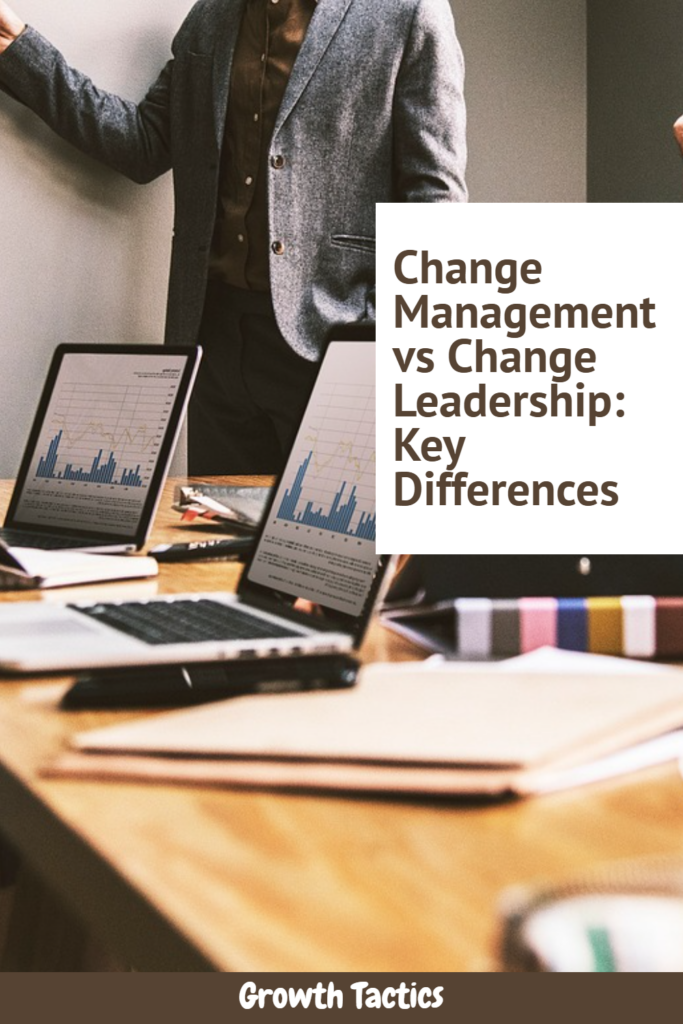Change is a constant in business, but how we handle it can make or break our success.
I’ve seen many leaders struggle with this firsthand. Are you managing change, or are you leading it? There’s a big difference, and it matters more than you might think.
In my years of leading, I’ve learned that change management and change leadership are two very different approaches.
Both are important, but they serve different purposes. Today, we’re going to explore what sets them apart and why it matters to you as a leader. Whether you’re steering a small team or a large organization, understanding these differences can be a game-changer.
So, let’s dive in and discover how you can become not just a manager of change, but a true change leader.
Jump To Section
1. Understanding the Basics
What is Change Management?
Change management is all about the nuts and bolts of making changes happen.
I’ve seen it in action many times. It’s like building a bridge, you need a plan, the right tools, and a step-by-step approach.
Change management focuses on processes, systems, and structures.
It’s about making sure everyone knows what’s happening and how to do their part. In my experience, good change management helps things run smoothly. It keeps people informed and reduces confusion.
But it’s just one piece of the puzzle.
What is Change Leadership?
Change leadership is different. It’s about inspiring people to want change.
Leaders who excel at change leadership don’t just tell people what to do. They paint a picture of a better future. They get people excited about the journey.
Change leadership is about helping people see why change matters and how they can be part of it.
How do Change Management vs Change Leadership Differ in Definition?
The main difference is in their focus.
Change management is about the “how”. How we’ll make changes happen. Change leadership is about the “why”. Why we need to change and why it matters.
I like to think of it this way: change management is the map, but change leadership is the compass. Both are important for getting where you want to go.
Change management deals with processes and plans. Change leadership deals with people and purpose.
One without the other is like trying to row a boat with only one oar, you’ll just go in circles.
2. The Goals and Objectives
What are the Primary Goals of Change Management?
Change management aims to make transitions smooth and successful.
The main goals are:
- To minimize disruption during change
- To keep everyone informed and on the same page
- To make sure new processes are adopted quickly
Good change management helps people feel more comfortable with new ways of doing things.
What are the Key Objectives of Change Leadership?
Change leadership has different objectives. It’s all about inspiring and guiding people through change.
The key objectives include:
- Creating a compelling vision for the future
- Motivating people to embrace change
- Empowering individuals to contribute to the change process
I remember when I first started focusing on change leadership. It was amazing to see how people’s attitudes shifted when they felt inspired and involved.
How do the Goals of Change Management Align with Organizational Success?
Change management goals are crucial for organizational success. They help ensure that changes stick and deliver the intended benefits.
When changes are managed well:
- People adapt more quickly
- Productivity stays high during transitions
- New systems and processes are used effectively
I’ve seen organizations save time and money by managing change well. Good preparation and care lead to better results.
In what ways do Change Leadership Objectives Inspire Innovation?
Change leadership objectives are powerful drivers of innovation. They create an environment where new ideas can flourish.
Here’s how:
- They encourage people to think creatively about the future
- They create a safe space for trying new things
- They celebrate initiative and risk-taking
I’ve found that when people feel inspired and empowered, they come up with amazing ideas. It’s like unlocking a treasure chest of creativity.
3. Approaches and Strategies
What Strategies Are Commonly Used in Change Management?
Change management uses several strategies to make transitions smoother. I’ve seen these work well in many situations.
Some common strategies include:
- Clear communication plans
- Training programs
- Feedback loops
- Milestone tracking
These strategies help people adapt to change. They make sure everyone knows what to do and when to do it.
What Approaches are Effective in Change Leadership?
Change leadership takes a different approach. It’s about inspiring and guiding people through change.
Effective approaches I’ve used include:
- Storytelling to paint a picture of the future
- Leading by example
- Empowering others to take initiative
- Celebrating small wins along the way
These approaches help people feel excited about change. They create a sense of purpose and involvement.
4. The Role of Leaders and Managers
What Skills are Essential for Managing Change?
Change managers need a special set of skills to handle change well. These skills help them navigate tricky waters.
Key skills include:
- Clear communication
- Problem-solving
- Adaptability
- Organization
Think of these skills as tools in a toolbox. The more you practice using them, the better you’ll handle any change that comes your way.
What Qualities Make a Change Leader Effective?
Effective change leaders have certain qualities that set them apart. These qualities help them inspire and guide others.
Important qualities are:
- Vision
- Courage
- Empathy
- Resilience
These qualities are like superpowers for leading change. They help you connect with people and keep everyone moving forward, even when things get tough.
Remember, whether you’re a manager, a leader, or both, your role in change is crucial.
5. Communication and Engagement
How Important is Communication in Change Management?
Communication is the heartbeat of change management. Without it, change efforts can fall flat.
In my years of managing change, I’ve learned that clear communication:
- Reduces confusion
- Builds trust
- Keeps everyone on the same page
Remember, people can’t follow a plan they don’t understand. Good communication lights the way forward to successful change.
What Role Does Engagement Play in Change Leadership?
Engagement is the secret sauce of change leadership. It turns passive observers into active participants.
When you engage people in change, you:
- Tap into their creativity
- Build commitment
- Create a sense of ownership
Engagement isn’t just nice to have, it’s essential. It’s what turns a change initiative from “their project” to “our mission.”
How can Effective Communication Bridge the Gap Between Change Management and Change Leadership?
Effective communication is the bridge that connects change management and change leadership. It brings structure and inspiration together.
Here’s how it works:
- Change management provides the facts
- Change leadership adds the emotion
- Communication ties it all together
I use a mix of methods to communicate effectively:
- Town hall meetings for big announcements
- One-on-one chats for personal concerns
- Regular updates to keep everyone informed
Think of communication as the glue that holds your change efforts together. It ensures that the practical steps of change management align with the inspiring vision of change leadership.
Remember, everyone communicates differently.
Pay attention to how your team prefers to receive information. Some people like emails, others prefer face-to-face talks. The key is to be flexible and make sure your message gets through.
By mastering communication, you’ll be able to guide your team through any change with confidence.
6. Measuring Success
What Metrics are Used to Measure Success in Change Management?
Measuring success in change management is like checking your map on a long journey. It helps you know if you’re on the right track.
Common metrics I’ve used include:
- Adoption rates of new processes
- Productivity levels before and after change
- Employee satisfaction scores
Remember, numbers tell a story. But don’t forget to listen to your team’s feedback too. Sometimes the best insights come from a quick chat by the water cooler.
How is Success Evaluated in Change Leadership?
Evaluating success in change leadership is trickier. It’s about measuring the intangibles, the things you can feel but can’t always count.
I look for signs like:
- Increased team enthusiasm
- More open communication
- Willingness to embrace future changes
ZLeadership success often shows up in the little things. Keep your eyes open for positive shifts in your team’s attitude and behavior.
What Are the Key Performance Indicators for Both Change Management and Leadership?
Key Performance Indicators (KPIs) help you see the big picture of your change efforts. They combine the practical side of management with the people-focused side of leadership.
Some KPIs I’ve found useful are:
- Project milestones met on time
- Budget adherence
- Employee engagement levels
- Customer satisfaction scores
I use a mix of these KPIs to get a balanced view. It’s like checking both your speedometer and your fuel gauge when driving.
Remember, KPIs are tools, not rules.
Use them to guide your efforts, but don’t let them blind you to unexpected opportunities or challenges. Measuring success in change isn’t always straightforward. But with the right metrics and a keen eye for people’s reactions, you can get a good sense of how you’re doing.
Don’t be afraid to adjust your measures as you go.
What works for one change might not work for another. Stay flexible, stay observant, and most importantly, stay connected with your team.
Their success is your success.
7. Conclusion: Finding the Balance
Balancing change management and leadership is like walking a tightrope. You need both to stay steady and move forward during organizational change.
I’ve seen organizations focus too much on one side:
- Too much management? You get rigid processes but no inspiration.
- Too much leadership? You get big ideas but no clear path to follow.
The sweet spot is in the middle. It’s where structure meets vision, and plans meet passion.
In my experience, the best changes happen when we blend both approaches. It’s not always easy, but it’s worth the effort.
In the end, it’s about people. Give them a clear path and an inspiring vision, and watch how they can transform your organization.


